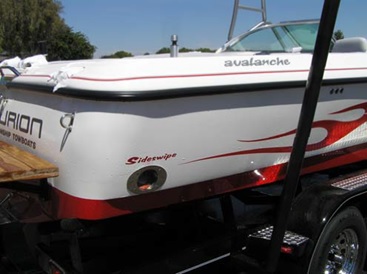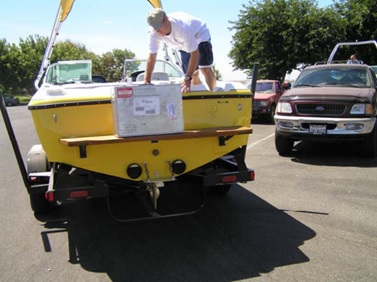Engineering Controls Database
Recreational Boats: Carbon Monoxide Exposure – Propulsion Engines Emission Controls (Exhaust Configurations)
|
Epidemiologic studies have found that from 1990 to 2004, there have been approximately 540 carbon monoxide (CO) poisonings associated with exhaust from gasoline-powered marine engines on recreational boats. Two hundred and twenty-five of the poisonings occurred on non-houseboats (other types of recreational boats) [DOI 2004]. There are approximately 17 million recreational boats used in the United States. Based upon the results of studies by the National Institute for Occupational Safety and Health (NIOSH), it is very likely that many of these gasoline-powered engines produce hazardous CO concentrations. The data collected in the one NIOSH study (171-31a) show that nearly 90% of the evaluated boat engines produced hazardous CO concentrations, and CO poisonings could occur from use of these engines under certain conditions. There are a variety of towed water sport activities in which CO exposures may occur. CO exposures are related to the distance behind the boat, height from the water, and operating speed. The most common of these sports are tubing, teak surfing, water skiing, wakeboarding, wake surfing, and knee boarding. |
|
| CO is a lethal poison that is produced when fuels such as gasoline or propane are burned. It is one of many chemicals found in engine exhaust resulting from incomplete combustion. Because CO is a colorless, odorless, and tasteless gas, it can overcome an exposed person without warning. The initial symptoms of CO poisoning may include headache, dizziness, drowsiness, or nausea. Symptoms may advance to vomiting, loss of consciousness, and collapse if prolonged or high exposures are encountered. If the exposure level is high, loss of consciousness may occur without other symptoms. Coma or death may occur if high exposures continue [NIOSH 1979]. The NIOSH Recommended Exposure Limit (REL) for CO is 35 ppm for full shift TWA exposure, with a ceiling limit of 200 ppm which should never be exceeded [CDC 1988]. The NIOSH REL is designed to protect workers for an 8-hour workday. NIOSH has also established an Immediately Dangerous to Life and Health (IDLH) value for CO of 1,200 ppm [NIOSH 2000]. | |
|
FAE system: In 2004, NIOSH researchers conducted an evaluation of CO emissions and exposures on a gasoline-powered, inboard ski boat that was equipped with a Fresh Air Exhaust™ (FAE) CO control system. The FAE system is a device that can be used on inboard ski boats to reroute engine exhaust from directly behind the boat near the water surface to approximately 1.5 feet below the water directly behind the propeller. The manufacturer has collected data showing that this device effectively removes CO from the air in the vicinity of the stern of the boat, as well as at numerous distances behind the boat [Mann, 2004]. The NIOSH evaluation occurred on a ski boat operating on Lake Austin, Austin, Texas with and without the FAE system. Sideswipe exhaust: In 2004, NIOSH researchers also conducted an evaluation of CO emissions and exposures on two gasoline-powered, inboard ski boats, one equipped with SideswipeTM exhaust (Figure 1) and the other with transom stern exhaust (Figure 2). The Sideswipe exhaust emits the engine exhaust from the side of the boat instead of the stern. The manufacturer (Fineline Industries) has collected data showing that this device effectively redirects CO from the vicinity of the stern of the boat, as well as numerous distances behind the boat.   |
|
| 171-05EE2; 171-31A; 171-35A; 171-37A; 289-11A; | |
|
CDC (1988). MMWR 37, supp (S-7) NIOSH Recommendations for Occupational Safety and Health Standards. Atlanta, GA, Dept. of Health and Human Services, Public Health Service, Centers for Disease Control and Prevention, National Institute for Occupational Safety and Health. DOI (2004). Department of the Interior (2004, October). Boat-Related Carbon Monoxide (CO) Poisonings. Retrieved January 19, 2004, from http://safetynet.smis.doi.gov/thelistbystate10-19-04.pdf Mann, L.W. (2004). Carbon Monoxide Exposure While Operating an Inboard Boat and Related Water Sports Activities. http://www.FreshAirExhaust.com. McCammon JB, Radtke T, et al. (2001). Letter of February 20, 2001 from J. McCammon, National Institute for Occupational Safety and Health, Centers for Disease Control and Prevention, Public Health Service, U.S. Department of Health and Human Services, T. Radke, U.S. Department of the Interior, and Dr. Robert Baron Prehospital Medical Care, Glen Canyon National Recreation Area, to Joe Alston, Park Superintendent, Glen Canyon National Recreation Area, Page, Arizona. Denver, CO, NIOSH. NIOSH (1979). A Guide to Work Relatedness of Disease. Cincinnati, OH, Dept. of Health Education and Welfare, Public Health Service, Centers for Disease Control, National Institute for Occupational Safety and Health. NIOSH (2000). Pocket Guide to Chemical Hazards and Other Databases: Immediately Dangerous to Life and Health Concentrations, DHHS (NIOSH). |
|
| 336612 | |
|
carbon monoxide carbon monoxide catalytic convertors catalytic convertors control technology control technology recreational boats recreational boats ski boats ski boats |
|
|
FAE system: The FAE manufacturer concluded in their study that at 5mph, FAE greatly reduces the risk of CO exposure within and on the swim platform of the boat, with a reduction up to 98% at the transom and minimal CO concentrations within the boat. At the same speed, the FAE increased some of the CO concentrations behind the boat. At 10 mph and 20 mph CO concentrations were minimal at all measured locations inside and behind the boat. The FAE manufacturer theorized that wet scrubbing may reduce the overall levels of CO released into the air. The NIOSH evaluation [171-35a] showed that CO concentrations measured while the boat was idling and traveling at 5 mph (inside the boat and behind the boat) were mixed depending on whether the FAE system was on or off (falling in some cases and increasing in others). At boat speeds of 10 and 15 mph, CO concentrations on and behind the boat were significantly reduced when the FAE system was used. The FAE system reduced CO exposures to wake surfers by approximately 80%; however, in general the wake surfer exposures were fairly low even without the FAE system (mean = 17 ppm). Sideswipe exhaust: The NIOSH evaluation (171-37a) noted that the highest CO concentration measured on the boats was at the stern. Peak CO concentrations at the stern of the idling boat were 1089 ppm for the transom exhaust boat and 153 ppm for the Sideswipe exhaust boat with the exhaust from both sides of the boat, and 154 ppm with the exhaust from the starboard side. Peak CO concentrations at the stern of the boat while traveling at 5 mph were 382 ppm for the transom exhaust boat and 163 ppm for the Sideswipe boat exhausting from both sides of the boat and 111 ppm exhausting from the starboard side. Peak CO concentrations at the stern of the boat while traveling at 10 mph were 336 ppm for the transom exhaust boat and 48 ppm for the Sideswipe boat exhausting from both sides of the boat and 242 ppm exhausting from the starboard side. Peak CO concentrations at the stern of the boat while traveling at 15 mph were 226 ppm for the transom exhaust boat and 41 ppm for the Sideswipe boat exhausting from both sides of the boat and 72 ppm exhausting from the starboard side. All of the CO concentrations for transom exhaust boat at various speeds exceeded the NIOSH REL of 200 ppm ceiling, while none of the CO concentration for the Sideswipe exhaust boat whether exhausting from both sides or from the starboard side exceeded this REL. |
